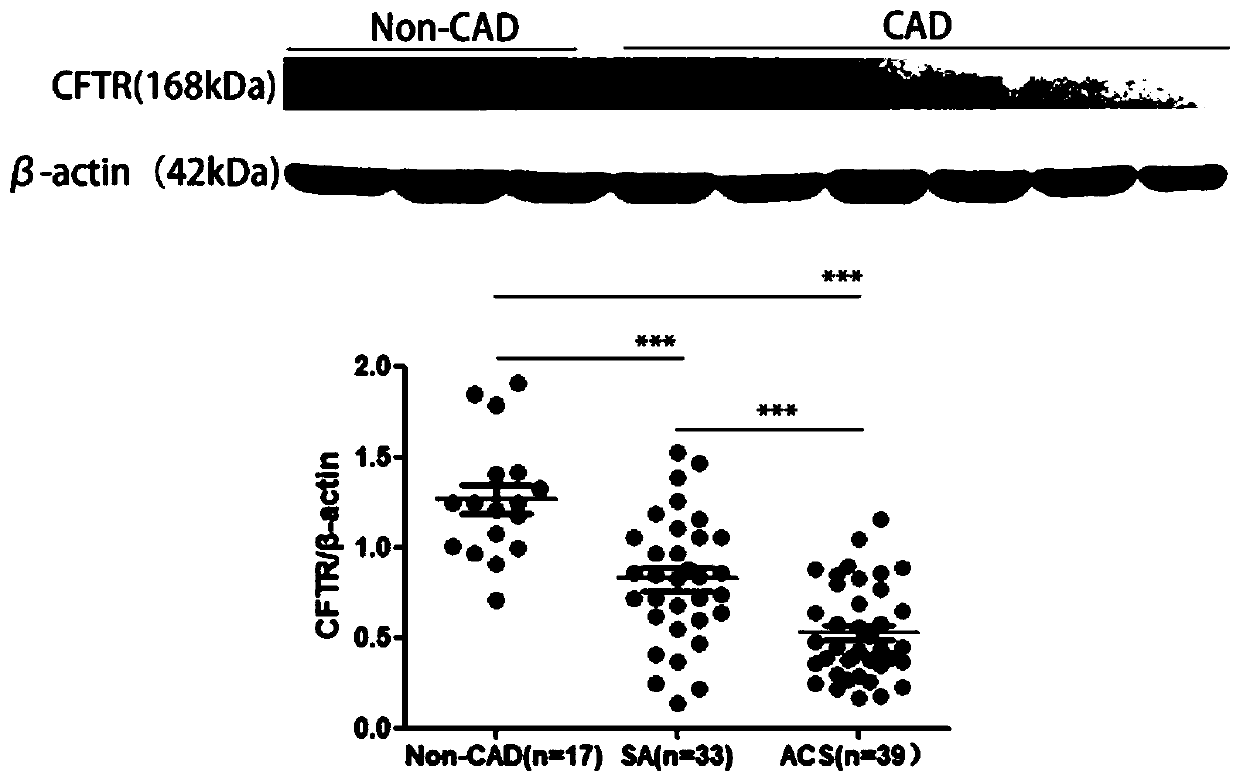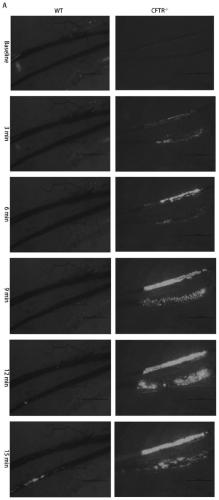Application of CFTR gene to preparation of thrombotic disease early warning or diagnosing medicine
A thrombotic disease, 1. CFTR technology, applied in the application field of CFTR gene in the preparation of early warning or diagnosing thrombotic disease drugs, can solve the problems of lack of specific diagnosis, affecting the quality of life and economic burden of patients, lack of specificity, etc.
- Summary
- Abstract
- Description
- Claims
- Application Information
AI Technical Summary
Problems solved by technology
Method used
Image
Examples
Embodiment 1
[0016] Example 1 Changes in CFTR protein levels of platelets in peripheral blood of normal people and patients with coronary heart disease
[0017] (1) Materials and methods
[0018] 1. Collection and grouping of peripheral blood of clinical patients
[0019] Peripheral blood from the population was collected from Guangdong Provincial People's Hospital after approval by the Ethics Committee of Guangdong Provincial People's Hospital. According to the clinical diagnosis index, it is divided into Non-CAD group (non-coronary artery disease group), SA group (stable angina pectoris group), ACS group (acute coronary syndrome group)
[0020] 2. Human Platelet Preparation
[0021] After disinfecting the elbow skin of the volunteers, draw venous blood, put the blood into an anticoagulant tube, anticoagulate the blood and anticoagulant with sodium citrate at a ratio of 9:1; centrifuge at 300g for 3 minutes at room temperature, and gently draw the upper Put platelet rich plasma (Platel...
Embodiment 2
[0028] Example 2 Changes of CFTR protein levels in peripheral blood mononuclear cells of normal people and patients with coronary heart disease
[0029] (1) Materials and methods
[0030] 1. Decreased expression of CFTR on monocytes of patients with ACS
[0031] (1) Preparation of peripheral blood mononuclear cells: The liquid (1.5 ml) in the anticoagulated blood sample was gently mixed with D-Hank’s buffer, and the total volume was 3 ml. In a 15ml centrifuge tube, carefully pour the diluted sample onto the surface of 3ml of Ficoll solution. To obtain peripheral blood mononuclear cells, samples were centrifuged at 800g×20min at room temperature. After centrifugation, a mononuclear cell layer should appear between the Ficoll solution and the plasma. Collect monocytes (1mL) and wash with 8ml of D-Hank's buffer before centrifugation at 300g×5min, and repeat twice. The monocytes were then resuspended in serum-free RPMI 1640 medium and seeded at 35 mm 2 Petri dish. Cells wer...
Embodiment 3
[0035] Example 3 Ferric chloride-induced mesenteric arteriolar thrombosis model
[0036] (1) Materials and methods
[0037] Experimental principle: The model of mouse mesenteric arteriole thrombosis induced by FeCl3 is to label mouse platelets with fluorescent dye (Calcein-AM, calceinacctoxymethyester) in vitro, inject tail vein back into experimental or control mice, and treat with FeCl3 The mesenteric arterioles injure the vascular endothelium, induce the formation of thrombus at the damaged site, and observe the formation of arterial thrombus in real time under the fluorescence microscope.
[0038] 1. Mice were anesthetized with 10% sodium pentobarbital
[0039] 2. Fix the mouse on the operating table, separate the abdominal aorta of the mouse, and use a 2ml syringe to take blood from the abdominal aorta. Add 3.8% sodium citrate anticoagulant to the syringe in advance, and the ratio of blood to anticoagulant The ratio is 9:1. After taking the blood, transfer the blood to ...
PUM
 Login to View More
Login to View More Abstract
Description
Claims
Application Information
 Login to View More
Login to View More - R&D
- Intellectual Property
- Life Sciences
- Materials
- Tech Scout
- Unparalleled Data Quality
- Higher Quality Content
- 60% Fewer Hallucinations
Browse by: Latest US Patents, China's latest patents, Technical Efficacy Thesaurus, Application Domain, Technology Topic, Popular Technical Reports.
© 2025 PatSnap. All rights reserved.Legal|Privacy policy|Modern Slavery Act Transparency Statement|Sitemap|About US| Contact US: help@patsnap.com



